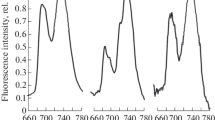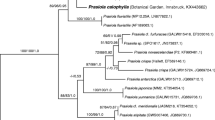Summary
The effect of high temperatures on the photosynthetic apparatus of Preissia quadrata (Scop.) Nees, Conocephalum conicum (L.) Dum. and Marchantia polymorpha L. were investigated. changes in the activities of various photosynthetic reactions were followed by measuring light-dependent oxygen evolution, chlorophyll a fluorescence and light-induced absorbance changes at 518 nm.
Mild heat treatment of the thalli led to reversible depression of photosynthesis; the period necessary for complete recovery depended on the extent of heat damage. Irreversible inactivation of photosynthesis after more severe heat stress was caused by damage of photosystem II. On principle, the pattern of reversible and irreversible heat inactivation of photosynthetic reactions in liverwort thalli resembles that observed in leaves of higher plants. However, in contrast to a number of Spermatophyta, exposure of liverwort thalli to high sublethal temperatures did not result in a significant increase in the heat stability of the photosynthetic apparatus indicating that the heat hardening capacity of hygrophytic hepatics is extremely low.
Similar content being viewed by others
References
Alexandrov VY (1977) Cells, molecules and temperature. Conformational flexibility of macromolecules and ecological adaptation. Ecological studies, vol 21. Springer, Berlin Heidelberg New York
Antropova TA (1974) Temperature adaptation studies on the cells of some bryophyte species. Tsitologiya 16:38–42 (in Russian)
Bauer H (1972) CO2-Gaswechsel nach Hitzestreß bei Abies alba Mill. und Acer pseudoplatanus L. Photosynthetica 6:424–434
Bauer H, Senser M (1979) Photosynthesis of ivy leaves (Hedera helix L.) after heat stress. II. Activity of ribulose bisphosphate carboxylase, Hill reaction and chloroplast ultrastructure. Z Pflanzenphysiol 91:359–369
Berry J, Björkman O (1980) Photosynthetic response and adaptation to temperature in higher plants. Ann Rev Plant Physiol 31:491–543
Bilger H-W, Schreiber U, Lange OL (1984) Determination of leaf heat resistance: comparative investigation of chlorophyll fluorescence changes and tissue necrosis methods. Oecologia (Berlin) 63:256–262
Dircksen A (1964) Vergleichende Untersuchungen zur Frost-, Hitze- und Austrocknungsresistenz einheimischer Laub- und Lebermoose unter besonderer Berücksichtigung jahreszeitlicher Veränderungen. Diss Göttingen
Hearnshaw GF, Proctor MCF (1982) The effect of temperature on the survival of dry bryophytes. New Phytol 90:221–228
Junge W, Jackson JB (1982) The development of electrochemical potential gradients across photosynthetic membranes. In: Govindjee (ed) Photosynthesis, vol 1. Academic Press, New York, pp 589–646
Kappen L (1981) Ecological significance of resistance to high temperature. In: Lange OL, Nobel PS, Osmond CB, Ziegler H (eds) Physiological plant ecology, vol 1. Springer, Berlin Heidelberg, pp 439–474
Krause GH, Santarius KA (1975) Relative thermostability of the chloroplast envelope. Planta 127:285–299
Krause GH, Weis E (1984) Chlorophyll fluorescence as a tool in plant physiology. II. Interpretation of fluorescence signals. Photosynthesis Research 5:139–157
Kulandaivelu G, Senger H (1976) The 520 nm absorbance changes in Scenedesmus obliquus and its relation to photosystem I. Biochim Biophys Acta 430:94–104
Lange OL (1955) Untersuchungen über die Hitzeresistenz der Moose in Beziehung zu ihrer Verbreitung. I. Die Resistenz stark ausgestrockneter Moose. Flora 142:381–399
Lösch R, Kappen L (1983) Die Temperaturresistenz makaronesischer Sempervivoideae. Verh Ges Ökologie 10:521–528
Nörr M (1974) Hitzeresistenz bei Moosen. Flora 163:388–397
Santarius KA (1975) Sites of heat sensitivity in chloroplasts and differential inactivation of cyclic and noncyclic photophosphorylation by heating. J Thermal Biol 1:101–107
Santarius KA, Müller M (1979) Investigations on heat resistance of spinach leaves. Planta 146:529–538
Schreiber U, Armond P (1978) Heat-induced changes of chlorophyll fluorescence in isolated chloroplasts and related heat-damage at the pigment level. Biochim Biophys Acta 502:138–151
Schreiber U, Berry JA (1977) Heat-induced changes of chlorophyll fluorescence in intact leaves correlated with damage of the photosynthetic apparatus. Planta 136:233–238
Schuurmans JJ, Leeuwerik FJ, Sin Oen B, Kraayenhof R (1981) Deconvolution of the flash-induced carotinoid and oxonol VI responses in brocken chloroplasts. In: Akoyunoglou G (ed) Proceedings of the 5th International Congress on Photosynthesis, vol 1. Balaban International Sciences Services, Philadelphia, pp 543–552
Umbreit WW, Burris RH, Staufer JF (1968) Manometric Techniques, 4 ed. Burgess Publ Co, Minneapolis
Velthus BR (1978) A third site of proton translocation in green plant photosynthetic electron transport. Proc Natl Acad Sci USA 75:6031–6034
Weis E (1981a) Reversible heat-inactivation of the Calvin cycle: a possible mechanism of the temperature regulation of photosynthesis. Planta 151:33–39
Weis E (1981b) The temperature-sensitivity of dark-inactivation and light-activation of the ribulose-1, 5-bisphosphate carboxylase in spinach chloroplasts. FEBS Letters 129:197–200
Weis E (1981c) Reversible effects of high, sublethal temperatures on light-induced light scattering changes and electrochromic pigment absorption shift in spinach leaves. Z Pflanzenphysiol 101:169–178
Weis E (1983) Investigations on the heat-sensitivity of thylakoid membranes in spinach leaves: the influence of light and short-time acclimatization to high temperatures. In: Marcelle R, Clijsters H, van Poucke M (eds) Effects of stress on photosynthesis. Martinus Nijhoff, Dr W Junk Publ, The Hague Boston London, pp 295–304
Weis E (1984) Short term acclimation of spinach to high temperatures: effect on chlorophyll fluorescence at 293 and 77 Kelvin in intact leaves. Plant Physiol 74:402–407
Weis E (1985) Light-and temperature-induced changes in the distribution of excitation energy between Photosystem I and Photosystem II in spinach leaves. Biochim Biophys Acta 807:118–126
Yordanov IT, Weis E (1984) The influence of leaf-aging on the heat-sensitivity and heat-hardening of the photosynthetic apparatus in Phaseolus vulgaris. Z Pflanzenphysiol 113:383–393
Author information
Authors and Affiliations
Rights and permissions
About this article
Cite this article
Weis, E., Wamper, D. & Santarius, K.A. Heat sensitivity and thermal adaptation of photosynthesis in liverwort thalli. Oecologia 69, 134–139 (1986). https://doi.org/10.1007/BF00399049
Received:
Issue Date:
DOI: https://doi.org/10.1007/BF00399049




